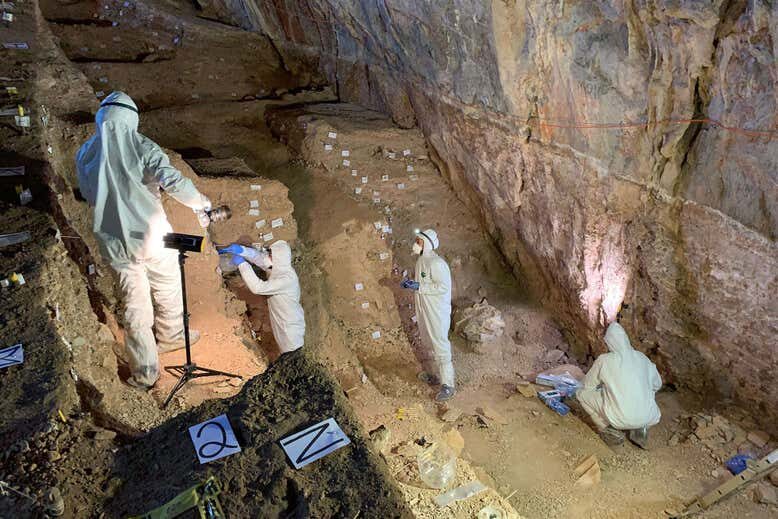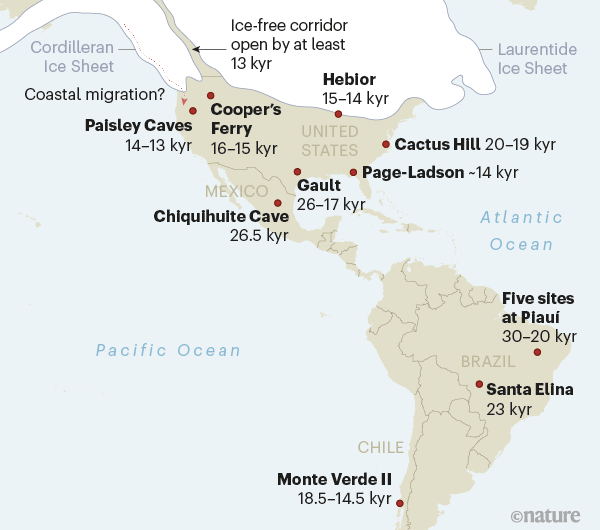
Following discoveries in the 1930s on the American Great Plains of distinctive, well-crafted stone spear points — of a type connected with the Clovis culture — alongside bones of mammoths, mastodons and a now-extinct bison species, archaeologists maintained, for many of the following decades, that the earliest people in the Americas were specialized big-game hunters who very rapidly expanded into North and South America, within 1,000 years of initial entry13. This model became known as the Clovis-first theory. It was later established that Clovis technology did not reach the southern continent. The time of their entry from Alaska into what is now the continental United States was thought to coincide with the opening of an ice-free corridor (Fig. 1) by around 13,000 years ago between the great northern continental ice sheet (called the Laurentide Ice Sheet) and the ice-covered northern Rocky Mountains (the Cordilleran Ice Sheet) in western Canada.
However, beginning in the mid-1970s, researchers identified archaeological sites in the Americas dated to earlier than 13,000 years ago, especially in South America. For example, the site of Monte Verde II in south-central Chile, initially dated to 14,500 years ago3, is a well-preserved open settlement with wooden structures and artefacts indicating a lifestyle based mainly around a diet of plants (subsequent discoveries revealed earlier occupations of this site14). Other early archaeological sites in South America on the Pacific coast, in the northern and central Andes, on the Caribbean coast, in the Brazilian uplands, in the Amazon basin, and on the Patagonian steppe in Argentina indicate that all major environmental zones of the region were occupied by people with diverse ecological adaptations and technologies before around 13,000 years ago4.Figure 1 | The early peopling of the Americas. During the last ice age, glaciers blocked entry by land into the Americas until an ice-free corridor opened up. Whether people first entered the Americas through this corridor, by a coastal route or before glaciers blocked the way is unknown, and the timing of this initial entry remains to be resolved. Becerra-Valdivia and Higham2 report analysis of 42 archaeological sites in North America and Beringia (the land mass in the Bering Strait area that previously joined Alaska and Siberia) that provide evidence for earlier widespread human occupation of this region than was previously reported. Some examples of sites associated with early human occupation are shown. Ardelean et al.1 report the discovery of a site associated with human occupation at Chiquihuite Cave in Mexico from 27,000 years ago. This adds to previous, debated evidence of early occupation of South America in sites at Monte Verde II3,14, Santa Elina12 and in the state of Piauí6-11 at Toca do Boqueirão da Pedra Furada7, Vale da Pedra Furada8, Toca do Sitio do Meio9, Toca da Tira Peia10 and Toca da Janela da Barra do Antonião-North11. kyr, thousand years ago.
Becerra-Valdivia and Higham carried out a statistical analysis of radiocarbon dates from early archaeological sites widely distributed over the continent of North America and Beringia (the land that once joined Alaska and Siberia in the Bering Strait area). Their results now establish that, by 15,000 years ago, North America was also widely settled, with some data suggesting sparse occupation earlier than that; and several distinctive regional traditions in stone-tool technology had developed by 13,000 years ago. On the evidence of these early archaeological sites from more than 13,000 years ago, identified on both continents, the Clovis-first model must be discarded. Clearly, people were in the Americas long before the development of Clovis technology in North America.
Instead, the key issue becomes how much earlier the Americas were initially peopled than was previously thought. One aspect to consider is the route or routes that people took in expanding south of Alaska. This is the assumed entry point from northeast Asia through the Bering Strait area. However, for a long interval during the last major glacial advance (dated to between about 26,500 and 19,000 years ago15), the obvious route by land down through the lowlands east of the Rocky Mountains was blocked by the merger of the Cordilleran and Laurentide ice sheets. An alternative route down the Pacific coast by populations adapted to life at the shoreline has gained strength as a possibility, as a result of increasing archaeological research in coastal zones16. Another option to consider is an initial entry before the closure of the ice-free corridor during the last major glacial advance.
This is where the evidence from Chiquihuite Cave comes in. After an initial test excavation suggested that the site was of great antiquity, Ardelean and colleagues continued their research using a range of scientific techniques. They recovered stone artefacts of a distinctive technology located in layers with dates corresponding to around 27,000 years ago in the lowest parts of the cave's sedimentary deposits, and the authors uncovered more artefacts in higher layers that dated to up to 13,000 years ago. The dating for the layer with the earliest artefacts indicates that there were people in northern Mexico at a time corresponding to the beginning of, or early during, the last major stage of glacial advance in North America.
Ardelean and colleagues' suggestion that the initial entry date was as far back as 33,000 years ago, which is more than double the currently popular date of around 16,000 years ago, will be very hard for most archaeologists specializing in early America to accept. There will undoubtedly be challenges to this interpretation and close examination of the site data. The six Brazilian archaeological sites dated as older than 20,000 years ago, five in the centre of the state of Piauí6-11 and one in central Mato Grosso (the Santa Elina rock shelter)12, although expertly excavated and analysed, are commonly disputed or simply ignored by most archaeologists as being much too old to be real. The findings at Chiquihuite Cave will bring about fresh consideration of this issue.
One unanswered question is why no archaeological site of equivalent age to Chiquihuite Cave has been recognized in the continental United States, assuming that, with a Bering Straits entry point, the earliest people expanding south must have passed through that area. With the coastal-entry model, it might be presumed that the earliest archaeological sites are now submerged offshore by the rise in sea level at the end of the last ice age. For the continental interior, it might be a matter of identifying and carefully investigating geological or palaeontological localities of appropriate age, searching for traces of human presence, and re-examining previously discounted archaeological sites and collections for now-recognizable evidence of human behaviour. In the light of these new discoveries, archaeological research into this period should intensify.
doi: 10.1038/d41586-020-02137-3 References1.




Comment: The facts may be hard for some achaeologists to accept but the evidence is becoming hard to ignore:
- Mysteries of Americas earliest inhabitants revealed deep inside Yucatan caves
- Genome studies support influence of Native Americans on Polynesians
- Ancient Siberia was home to previously unknown humans - Theory of Native American ancestors rewritten
- Ancient skulls from Mexico surprisingly diverse, challenges assumptions about settlement of the Americas
- Aguada Fenix: Major discovery of oldest and largest ceremonial structure in Mexico
- America Before by Graham Hancock - Book review
- Ancient Siberia was home to previously unknown humans - Theory of Native American ancestors rewritten
Also check out SOTT radio's: